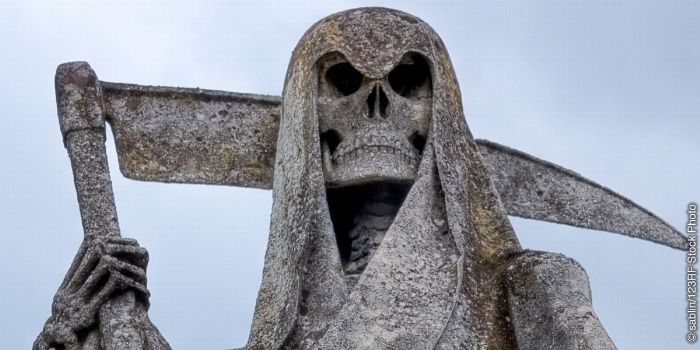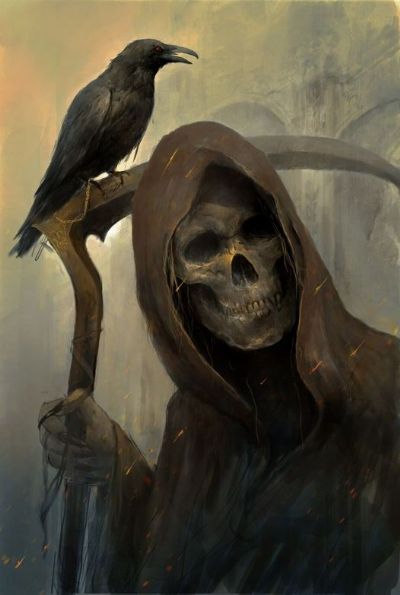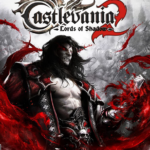In modern-day European-based folklore, Death is known as the Grim Reaper depicted in the as wearing a dark hooded cloak and wielding a scythe.

During the plague in the early 141th century, artists began painting death as a horrific figure. Skeletons, armed with deadly weapons, danced among plague victims in the street or rode white horses with wagons full of bodies attached. Eventually, a black cloaked figure, the first recognizable Reaper, began appearing at the head of these ghastly processions. His dark costume and curved scythe may have been inspired by plague doctors, who wore dark shrouds and bird-like masks to protect themselves from breathing infected air.
Early versions connected with imagery of the plague often showed Death on a horse (or now-familiar skeletal horse), firing or carrying a bow. It must be remembered that the bow was the weapon of choice of Apollo, who often used arrows to deliver plague.
The garb of Death or the black mourning robe, which the first references are found in the early fifteenth century, is very close to the robe of the priest or monk who officiated at the death bed. It is interesting to note that the dead body itself was never garbed in black — the color of the winding sheet or shroud seems always to have been white.
The scythe is an image that reminds us that Death reaps the souls of sinners like the peasant harvest corn in his field. Each movement of the scythe brings thousands of souls.

In Greek mythology, Chronos (Cronus) was the king of titans and the father of Zeus. He was also a harvest god called Father Time and carried a sickle which is a tool used in harvesting grain. The Grim Reaper carrying a scythe are directly derived from Cronus. The myth of Chronos eating his children was used in a poetic sense for time devouring all things, as in the old saying “nothing lasts forever.”
The three Greek words that were either related originally or related through confusion later were: Chronus (meaning “time”), Cronus (the god of harvest before the Greek gods took over), and corone (meaning “crow”). Little wonder then that we often see a crow accompanying the Grim Reaper.
The earliest appearance of the name “Grim Reaper” in English is in the 1847 book The Circle of Human Life, although “the Grim” was a popular nickname for death dating all the way back to the thirteenth century.
All know full well that life cannot last above seventy, or at the most eighty years. If we reach that term without meeting the grim reaper with his scythe, there or there about, meet him we surely shall.
Fantasy and Horror novels regularly pay homage to the Grim Reaper. Films like Scream and Goblin have played off his dark look, while books like JK Rowling’s Harry Potter and the Deathly Hallows and Neil Gaiman’s The Graveyard Book have added new stories to the Reaper’s long legend.







